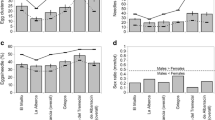Abstract
A study was carried out at the Natural Park of Montesinho, NE Portugal, in order to evaluate the effect of different pine species (Pinus pinaster Ait.,P. nigra Arn. andP. sylvestris L.) onThaumetopoea pityocampa populations. The structure of the egg batches, the impact of the egg parasitoids on natural mortality of the pest and the species of parasitoids present, as well as their emergence dynamics, were analyzed. The length of the egg batches varied among pine species with the longest ones onP. nigra. The mean number of eggs per batch differed betweenP. sylvestris and the two other hosts studied, with fewer eggs per batch on the first. No differences were found in the size of eggs among pine species. The egg mortality varied between 25.8% and 33.0%, with no differences among hosts. Parasitism was the main cause of death.Baryscapus servadeii (Mercet.) was the most abundant parasitoid species, followed byOoencyrtus pityocampae (Dom.) andTrichogramma embryophagum Htg.B. servadeii dominated in the egg batches collected fromP. pinaster andP. nigra, whereasO. pityocampae was most frequent onP. sylvestris. The emergence ofB. servadeii started in the middle of March and continued until August, with the emergence peak at the end of May. The emergence ofO. pityocampae started at the end of April and continued throughout September, with maximum values in June.
Similar content being viewed by others
References
Avtzis, N. (1986) Development ofThaumetopoea pityocampa (Den. and Schiff.) in relation to food consumption.Forest Ecol. Manag. 15:65–68.
Bellin, S., Schmidt, G.H. and Douma-Petridou, E. (1990) Structure, ooparasitoid spectrum and rate of parasitism of egg-batches ofThaumetopoea pityocampa (Den. & Schiff.) (Lep. Thaumetopoeidea) in Greece.J. Appl. Entomol. 110:113–120.
Bernays, E.A. and Chapman, R.F. (1994) Host-plant Selection by Phytophagous Insects. Chapman & Hall, New York, NY.
Buxton, R.D. (1983) Forest management and the pine processionary moth.Outlook Agric. 12:34–39.
Demolin, G. (1969) Comportement des adultes deThaumetopoea pityocampa Schiff. Dispersion spatiale, importance écologique.Ann. Forest Sci. 26:81–102.
Devkota, B. and Schmidt, G.H. (1990) Larval development ofThaumetopoea pityocampa (Den. & Schiff.) from Greece as influenced by different host plants under laboratory conditions.J. Appl. Entomol. 109:321–330.
Kanat, M., Alma, M.H. and Sivrikaya, F. (2005) Effect of defoliation byThaumetopoea pityocampa (Den. & Schiff.) (Lepidoptera: Thaumetopoeidae) on annual diameter increment ofPinus brutia Ten. in Turkey.Ann. Forest Sci. 62:91–94.
Lamy, M. (1990) Contact dermatitis produced by processionary caterpillars (Thaumetopoeidea).J. Appl. Entomol. 110:425–437.
Mirchev, P., Schmidt, G.H., Tsankov, G. and Avci, M. (2004) Egg parasitoids ofThaumetopoea pityocampa (Den. & Schiff.) (Lep., Thaumetopoeidea) and their impact in SW Turkey.J. Appl. Entomol. 128:533–542.
Oliveira, P., Arnaldo, P.S., Araújo, M., Ginja, M., Sousa, A.P., Almeida, O.et al. (2003) [Report of poison in five dogs after contact withThaumetopoea pityocampa.] Cinco casos clínicos de intoxicações por contacto com a larvaThaumetopoea pityocampa em cães.Rev. Port. Ciênc. Clín. 89:81–84 (Portuguese, with English abstract).
Schmidt, G.H., Tanzen, E. and Bellin, S. (1999) Structure of egg-batches ofThaumetopoea pityocampa (Den. & Schiff.) (Lep., Thaumetopoeidea), egg parasitoids and rate of egg parasitism on the Iberian Peninsula.J. Appl. Entomol. 123:449–458.
Tiberi, R., Niccoli, A., Curini, M., Epifâno, F., Marcotullio, M.C. and Rosati, O. (1999) The role of monoterpene composition inPinus spp. needles, in host selection by the pine processionary caterpillar,Thaumetopoea pityocampa.Phytoparasitica 27:263–272.
Tsankov, G., Schmidt, G.H. and Mirchev, P. (1995) Impact of parasitoids in egg-batches ofThaumetopoea pityocampa (Den. & Schiff.) in Algeria.Boll. Zool. Agrar. Bachic. 27:53–60.
Tsankov, G., Schmidt, G.H. and Mirchev, P. (1998) Studies on the egg parasitism inThaumetopoea pityocampa over a period of four years (1991–1994) at Marikostino/Bulgaria.Anz. Schädlkd. Pflanzenschutz Umweltschutz 71:1–7.
Author information
Authors and Affiliations
Corresponding author
Additional information
http://www.phytoparasitica.org posting Sept. 20, 2006.
Rights and permissions
About this article
Cite this article
Arnaldo, P.S., Torres, L.M. Effect of different hosts onThaumetopoea pityocampa populations in northeast Portugal. Phytoparasitica 34, 523–530 (2006). https://doi.org/10.1007/BF02981209
Received:
Accepted:
Issue Date:
DOI: https://doi.org/10.1007/BF02981209



